 |
JAMES BOND FACT FILES |
 |
JAMES BOND FACT FILES |
|
|||||||||||||||||||||||
|
|||||||||||||||||||||||
|
For Roger Moore's second appearance as James Bond in The Man With The Golden Gun (1974) EON Productions/DANJAQ once again granted several companies a license to promote their brand via the James Bond connection. Although some products were unusual choices for tie-ins with the film, they had actually appeared on screen in The Man With The Golden Gun, but not as obvious as other product placement seen in earlier entries in the long-running series. Movie audiences could be forgiven for not spotting that Nick Nack's (Hervé Villachaise) luxury kitchen was by Hygena, with appliances by Westinghouse; and the carpets in the film were by Du Pont! PAN Books were confident that their film tie-in paperback would be a best-seller and ordered a print run of 150,000 copies for release in December 1974. Sales of Ian Fleming's last James Bond novel THE MAN WITH THE GOLDEN GUN had just passed the one-million mark, but it had taken nine years to reach the magic figure. The initial print run of 150,000 did not sell out until May 1976, when a 12th and final printing of 20,000 copies was produced by PAN Books. |
|||||||||||||||||||||||
|
|||||||||||||||||||||||
 |
|||||||||||||||||||||||
|
|||||||||||||||||||||||
|
|
|||||||||||||||||||||||
|
The Man With The Golden Gun (1974) was the first James Bond film since Thunderball (1965) to be promoted via an advertising campaign to tie-in with the recent announcement of a top ‘ERNIE’ Premium Bond prize of £75,000. The National Screen Service produced 40,000 colour Double-crown (20" X 30") posters for the campaign featuring Roger Moore posing with ‘Miss Premium Bond’. |
|||||||||||||||||||||||
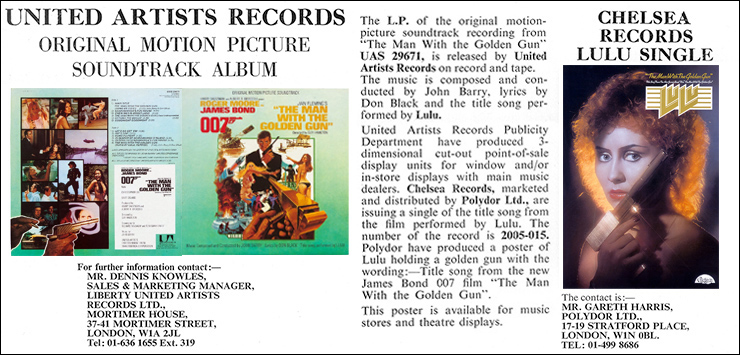 |
|||||||||||||||||||||||
|
Usually released a short time before the film opened in cinemas, the Original Soundtrack Album for The Man With The Golden Gun wasn't available until December 1974 as composer John Barry was still working on the score for John Schlesinger's The Day of The Locust (1975), which was recorded in Los Angeles over a week in mid-September. Barry then returned to the UK and had just three weeks to write and record the score for The Man With The Golden Gun. Five days of recording began on October 14, 1974 - although Lulu's title song had been recorded at CTS Studios in Wembley on September 4th. The single was released on November 22, 1974 - a month ahead of the premiere of The Man With The Golden Gun, but failed to make any impact on the UK chart despite being heavily promoted with posters [pictured above right] featuring the eponymous weapon. ‘The Man With The Golden Gun’ was then featured as the theme song heard over the opening titles (designed to look like the work of Maurice Binder) at the start of Lulu's new BBC television series which began on January 4, 1975 as the film was on general release across the UK. |
|||||||||||||||||||||||
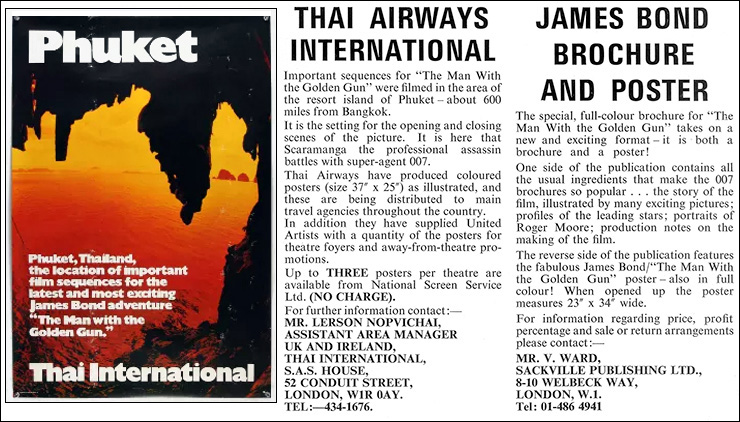 |
|||||||||||||||||||||||
|
To tie-in with the exotic location of Phuket in Thailand featured prominently in The Man With The Golden Gun, Thai Airways produced a colour poster (37" X 25") which was distributed to main travel agencies throughout the country. As with other airlines promotions for earlier Bond films, Thailand would be out of reach for the average cinemagoer, although the location did become a major tourist hot-spot in later years, and like Piz Gloria in Switzerland is still promoted via its James Bond connection over half a century later. |
|||||||||||||||||||||||
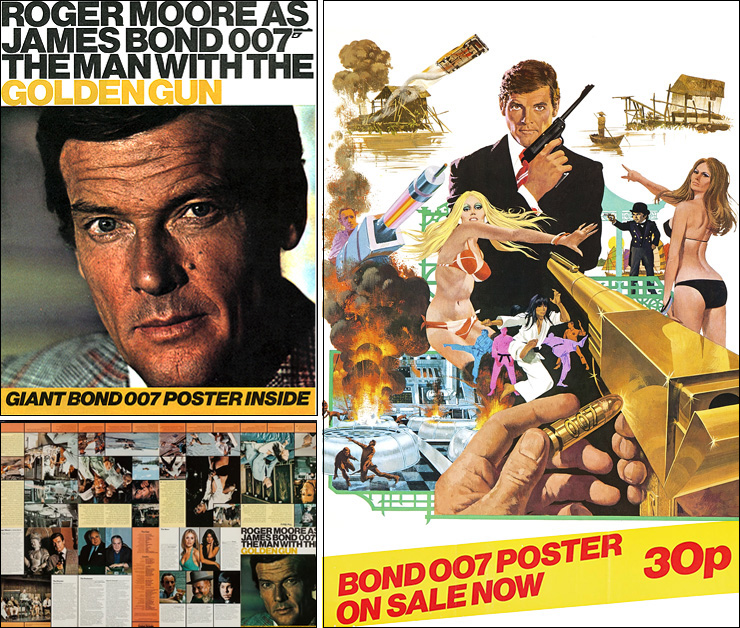 |
|||||||||||||||||||||||
|
Although not illustrated, the Exhibitors’ Campaign Book also listed a full-colour brochure and poster from Sackville Publishing Ltd. The folded brochure for The Man With The Golden Gun featured the usual promotional stills, story of the film, and cast & crew biographies. When opened up the 8-page publication measured 23" X 34", with the film poster artwork by Robert McGinnis on the reverse side, and the film title displayed below. Another poster [pictured above right] featuring the same artwork was also available for display in cinema foyers where the brochure was on sale for 30p. |
|||||||||||||||||||||||
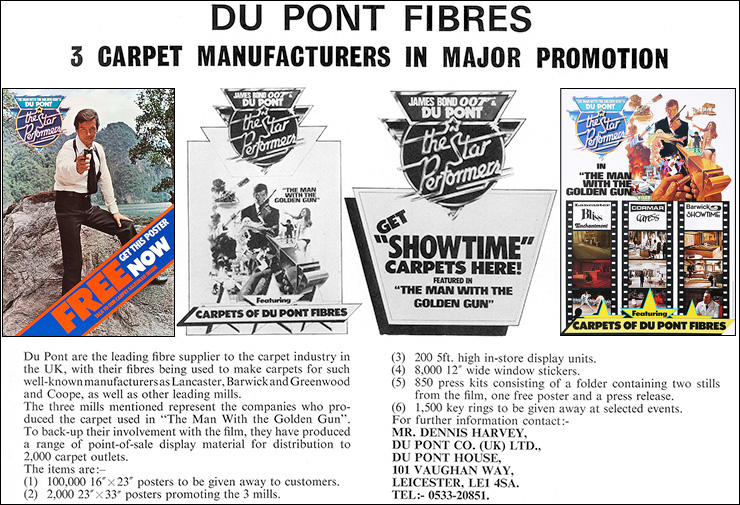 |
|||||||||||||||||||||||
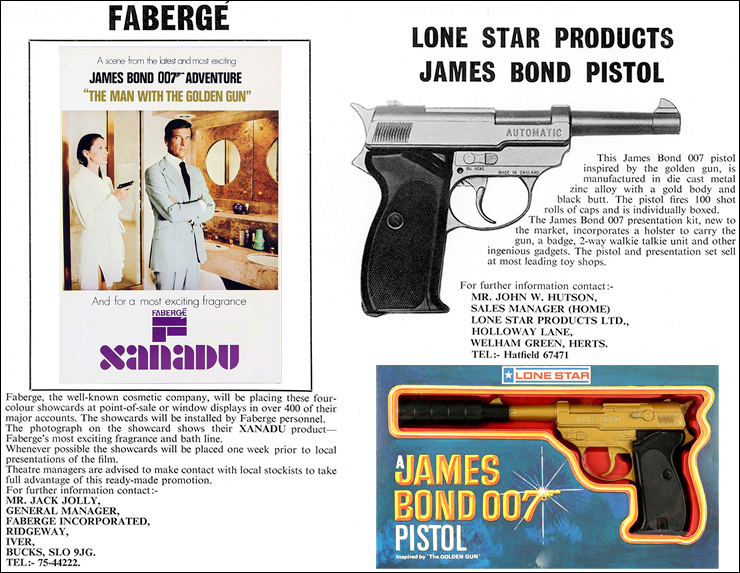 |
|||||||||||||||||||||||
|
Although their products were barely seen in the background of one scene in The Man With The Golden Gun (1974), Fabergé participated in a promotional tie-in with their XANADU fragrance and bath line, which had been launched in 1969. The campaign may have been made possible by Roger Moore, who had been a Fabergé ambassador since 1970, and managing director for European production for their offshoot film company Brut Productions. Although not credited on the series, Brut Productions were one of the companies behind Roger Moore's hit series The Persuaders! (1970-71) which co-starred Tony Curtis. Lone Star once again released their “James Bond Pistol” which had been linked to the film series since 1965. The packaging now stated that the pistol was inspired by “The GOLDEN GUN”. The toy was manufactured in die-cast metal zinc alloy with a gold body and black butt. A new presentation kit was also issued containing the gun and holster, with a badge and two-way walkie talkie seen in earlier sets. |
|||||||||||||||||||||||
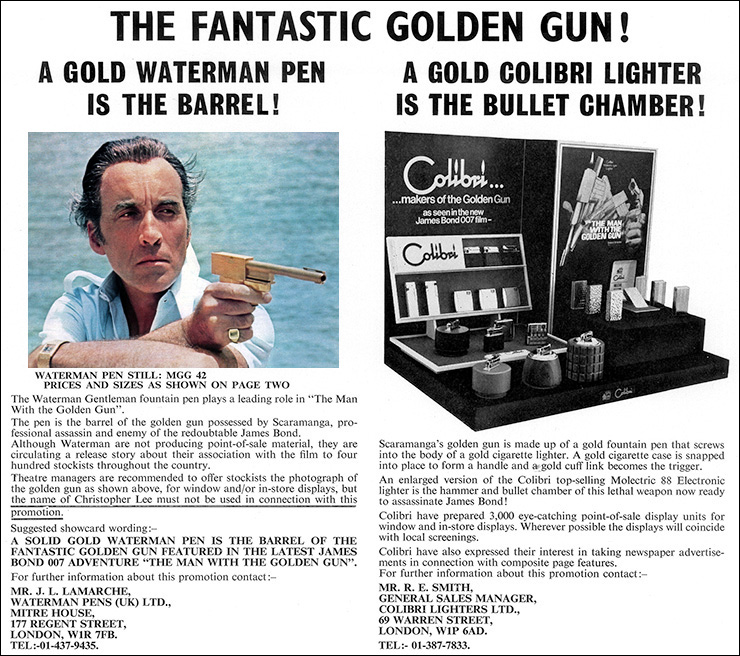 |
|||||||||||||||||||||||
|
The ‘Golden Gun’ of the title obviously featured heavily in the publicity for the film and formed the centrepiece of the Robert McGinnis posters, and Maurice Binder's theatrical trailers. The weapon was made up from four separate elements with a gold Waterman fountain pen as the barrel of the gun, which screwed into the body of a gold cigarette lighter that snapped into a cigarette case manufactured by Colibri, and a gold cuff link became the trigger. Although Waterman did not produce any point-of-sale material, they did circulate a press release about their association with the film to 400 stockists across the country, which was accompanied by a still of Christopher Lee holding the gun [pictured above left]. The Campaign Book insisted that the name of Christopher Lee must not be used in connection with this promotion. Christopher Lee [pictured below left at Heathrow Airport] did however undertake a publicity tour of the USA ahead of the release of The Man With The Golden Gun (1974) accompanied by a promotional version of the golden gun. Colibri produced 3,000 eye-catching point-of-sale display units featuring their unique artwork [pictured below right] for window and in-store displays. The end credits of The Man With The Golden Gun (1974) stated somewhat erroneously that the golden gun was made by Colibri Lighters, London, UK. Despite the high-profile publicity received by Colibri there are different stories regarding its origins. One story states that special effects expert John Stears made the gun from parts manufactured by both Colibri and pen manufacturer Waterman. Another told by art director Peter Lamont, states that he designed and made an alternative wooden template as the finished gun Colibri constructed was rushed and tended to fall apart while being handled. A wooden model made by Colibri was sold at auction in 2011. Lamont then hired a London silversmith to make the three screen-used props. According to Lamont, although Colibri made a number of high-quality golden guns for promotional purposes, no Colibri-made weapon was featured in the final film. However, Stears’ story and Colibri's official end credit on the production contradicts this. |
|||||||||||||||||||||||
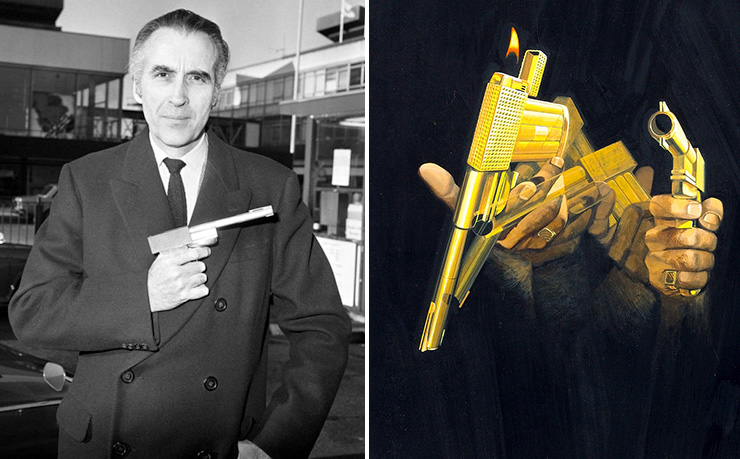 |
|||||||||||||||||||||||
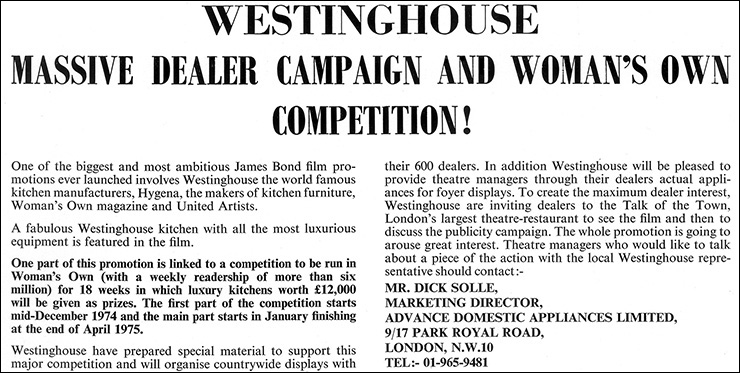 |
|||||||||||||||||||||||
|
Aimed at the female cinemagoer, a major competition was launched between world famous kitchen manufacturers Westinghouse; Hygena - the makers of kitchen furniture; Woman's Own magazine and United Artists. With a major prize worth a staggering £12,500 the competition was promoted in Woman's Own magazine between January 18 and April 26, 1975, and by a quad-crown poster (30" X 40") on display in cinema foyers and stores selling Westinghouse and Hygena products. All the luxury kitchen appliances in Nick Nack's (Hervé Villechaize) well-appointed kitchen on Scaramanga's (Christopher Lee) island hideaway (actually filmed at Pinewood Studios) were provided by the two companies. |
|||||||||||||||||||||||
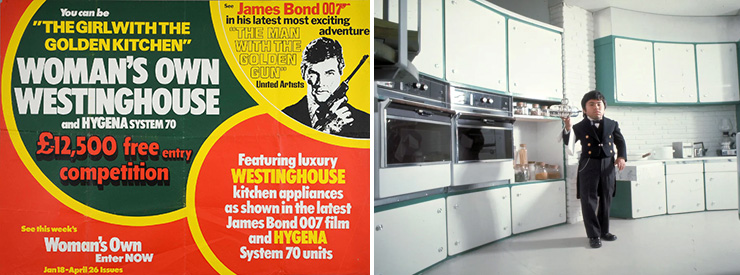 |
|||||||||||||||||||||||
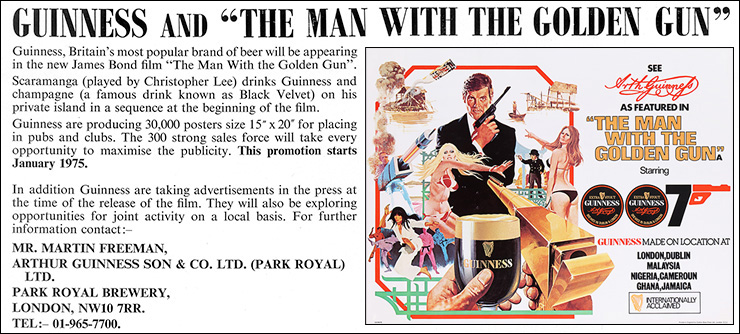 |
|||||||||||||||||||||||
|
|||||||||||||||||||||||
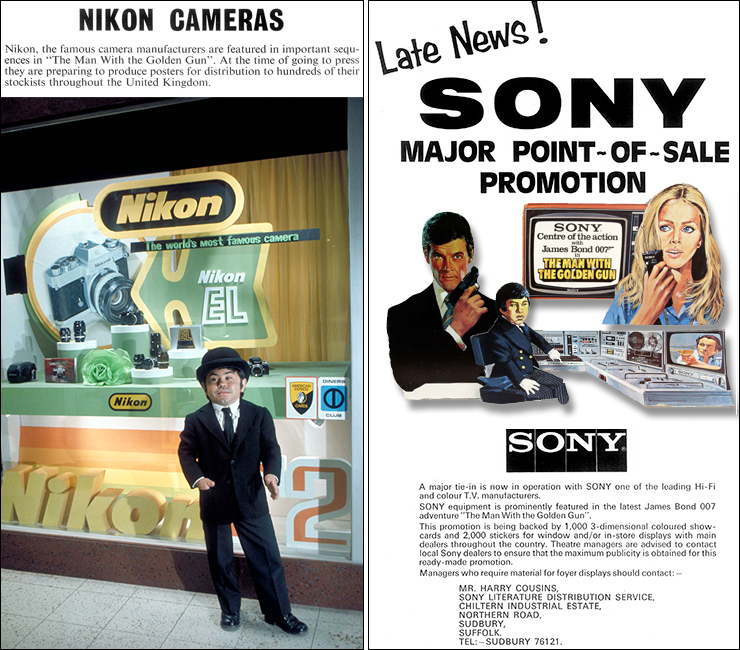 |
|||||||||||||||||||||||
|
A promotional tie-in with Japanese camera manufacturer NIKON - whose products were seen on screen in a store window during the scenes in Macau - was mentioned in the Exhibitors’ Campaign Book, but the promised poster was not available at the time of going to press. Another late tie-in with Japanese Hi-Fi and TV manufacturer SONY was also too late to be included in the Campaign Book, but an additional page was later inserted detailing the 3-dimensional showcards and stickers produced by the company for distribution to main dealers across the UK. |
|||||||||||||||||||||||
 |
|||||||||||||||||||||||
|
|||||||||||||||||||||||